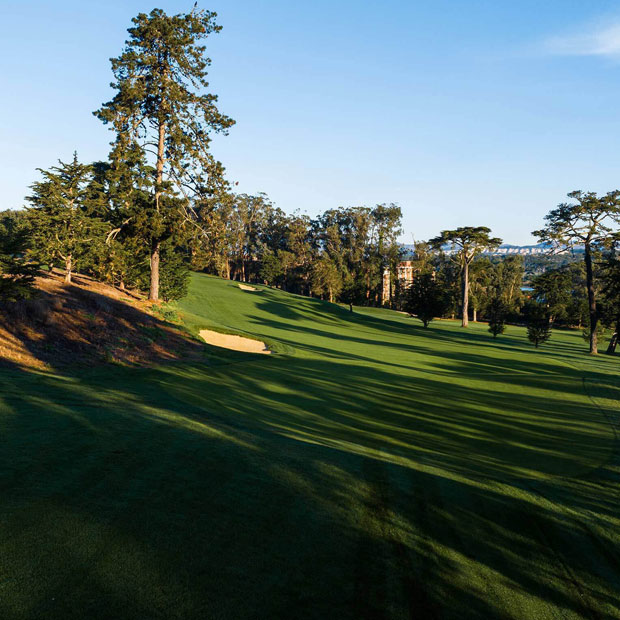Golf Course Architecture 101, Part 3: Hazards
An introduction to the use of hazards in golf course design


Without hazards golf would be but a dull sport, with the life and soul gone out of it. –Robert Hunter
Hazards come in innumerable shapes, sizes, and forms on golf courses. They are a key tool at an architect’s disposal, but they can also become a weakness. Used properly, hazards infuse beauty and strategic interest into a golf course; spectacular ones can create experiences that golfers will never forget. Used poorly, however, they can make players want to quit the game.
The purpose of hazards
The spirit of golf is to dare a hazard, and by negotiating it reap a reward, while he who fears or declines the issue of the carry, has a longer or harder shot for his second; yet the player who avoids the unwise effort gains advantage over one who tries for more than in him lies, or fails under the test. –George Thomas
The best hazards serve a specific purpose. They can enhance strategy, add a layer of deception, or provide excitement—or do all three at once.
Strategy: Riviera Country Club, 7th hole
{{content-block-golf-course-architecture-101-part-3-hazards-001}}
George Thomas and Billy Bell’s Riviera is one of the best-bunkered courses in the world. On the under-appreciated 7th hole, a magnificent fairway bunker puts long hitters in a pickle. Off the tee, they have to decide how aggressively they want to play. The father they hit their tee shot, the narrower the landing zone becomes. Meanwhile, less powerful players can simply take the cautious path (option A below).

The different options off the tee on the 7th hole at Riviera (Google Earth)
Option A (safe) – Laying back to the wide part of the fairway is the safest play but leaves a long approach shot to a tiny, heavily sloped green.
Option B (moderately risky) – Threading a longer tee ball into the narrowing fairway can yield a short-iron or wedge approach, but with every additional yard, the landing zone gets tighter.
Option C (risky) – Unless you can fly the bunker—a carry of about 320 yards—the most aggressive play is to the narrowest part of the fairway. The risk is substantial, but so is the potential reward: a wedge from the ideal angle.
All of these strategic options are generated by a single well-placed hazard.
Deception: Riviera Country Club, 10th hole
{{content-block-golf-course-architecture-101-part-3-hazards-002}}
No. 10 at Riviera gets a lot of praise for its strategic complexity, but it’s also subtly deceptive. The big, crescent-shaped bunker directs your attention to the center line of the hole, framing what appears to be the ideal landing zone. From the tee, the proper play seems to be either short of the bunker or over it. But that’s a trap: approaching the severely canted green from either of those spots, even with a wedge, is nearly impossible. It is far better to aim your tee shot well left.
This is one way in which a hazard can create visual deception, giving an advantage to the player see beyond the architect’s tricks and accurately assess the strategy of the hole.
Excitement: Cypress Point Club, 16th hole

The 16th hole at Cypress Point. Photo credit: Jon Cavalier @linksgems
This point is fairly self-explanatory. On the 16th hole at Cypress Point, the Pacific Ocean is obviously a hazard—if you miss right, left, or short, you’re in it—but it’s also simply amazing to look at. Play the hole once and you’ll never forget it.
Many of the world’s most memorable golf holes incorporate a beautiful natural feature as a hazard: Rae’s Creek on Nos. 12 and 13 at Augusta National; the big dune to the left of the Postage Stamp green at Royal Troon; and, of course, the seaside cliffs on several holes at Cypress Point’s public-access cousin, Pebble Beach.
The placement of hazards
“Hazards should be placed with an object in mind, and not one should be made which has not some influence of the line of play.” – Alister Mackenzie
With hazards, placement is everything, and less is often more. Each hazard should have some specific effect. A bunker on the inside of a dogleg may convince the player to aim toward the opposite side, where a longer approach awaits. A bunker short of the green may convince the player to club up and miss long. In other words, a well-placed hazard creates a dilemma: play close to it and reap an advantage, or take the safe route away from it and face a difficult next shot.
Furthermore, hazards should be placed to accommodate a variety of skill levels. Whereas proficient players should have to reckon with danger, beginners and shorter hitters should be able to avoid it with a reasonable degree of accuracy and caution. Therefore, forced carries such as those at No. 16 at Cypress Point and the island 17th at TPC Sawgrass should be used in moderation, no matter how thrilling they are. A course filled with such carries would be a slog for a low-trajectory player.
The best way to illustrate this principle is to look at a hole where the placement of hazards leaves a lot to be desired.
The Senator Course at Capitol Hill Golf Club, 1st hole

Oh boy, where to start…
There are nine bunkers on this Robert Trent Jones/Robert Rulewich-designed hole, and most of them are unnecessary. The first three are in play only for short hitters, who are unlikely to reach the green in regulation anyway. Why punish them further? A similar objection can be made to the bunkers in front of the green, which are threats mainly to golfers who can’t hit it high and far.
If you’re a skilled player, on the other hand, you don’t have much to think about on either the drive or the approach. Just cut the corner with your tee shot and get to the bunker-less section of the fairway. Then make sure your approach flies all the way to the pin. These aren’t difficult undertakings for low-handicap golfers, nor are they all that interesting.
So poorly placed hazards result in the worst of both words: too much difficulty for below-average players and too little for above-average ones.
(Side note: as I discussed in Part 2 of this series, proficient golf architects usually strive to blend artificial features in with the natural landscape. Jones and Rulewich did not accomplish this task at Capitol Hill. The bunkers on the first hole are nearly identical to each other in size and shape, and have no discernible relationship to the surrounding terrain. There must be those who enjoy this look, but I’m not one of them.)
Types of hazards
Hazards can take many different forms, some more subtle than others. The key is for a course to have a variety of hazards so that the look, feel, and playing characteristics of the holes don’t become repetitive and boring.
Bunkers
There’s a reason this article has focused primarily on bunkers: no hazard is more frequently used or more fundamental to the way we understand the strategy of golf. At many courses, bunkers have an influence on every full shot a player hits during a round.
{{content-block-golf-course-architecture-101-part-3-hazards-003}}
Yet in many cases, architects should exercise restraint in bunkering. Bunkers are expensive to build and maintain, and around the green, they tend to punish weaker golfers disproportionately. In fact, skilled players often prefer to be in a green-side bunker than in the rough.
Grass bunkers
If green-side sand bunkers widen the gap between low and high handicappers, grass bunkers do the opposite. They often give expert players fits, but they’re more playable for beginners, who are usually just looking to get the ball on the green. Also, grass bunkers are cheaper to build and maintain. For these reasons, they are extremely underused in modern golf architecture.

A grass bunker on the 10th hole at Sheep Ranch. Photo credit: Garrett Morrison
Water hazards
Water hazards can range from a tiny, meandering stream to a cliff at the edge of a mighty ocean. At their best, these hazards provide an unmatched thrill factor and enhance strategy by amping up risk. But these great benefits can turn into great drawbacks when a water feature is poorly built or poorly incorporated into the course. Water hazards can also be horribly overused, turning the average golfer’s round into a punishing experience. They can also be the most artificial-looking elements of a course; the best ones tend to be—or at least appear—indigenous to their settings.
{{content-block-golf-course-architecture-101-part-3-hazards-004}}
Natural landforms
Not every golf course is blessed with rock outcroppings, ravines, or sudden elevation changes that can readily serve as hazards. But when given a property that has these kinds of natural assets, an architect is duty-bound to maximize them.
{{content-block-golf-course-architecture-101-part-3-hazards-005}}
Contours
Contours are the most subtle and underrated type of hazard; sometimes they may not even seem to be hazards at all. Whether natural or manmade, contours can create strategic interest from tee to green: uneven lies in the fairway, humps and hollows on the approach, run-offs around the green, etc. These features become particularly lively when conditions are firm and there’s plenty of short grass.
Combining contouring with a fairway cut is a great way for an architect to blend challenge with playability. Unpredictable ground prevents better players from getting in a groove with their irons and wedges, but clean lies and the option to use a putter around the greens will help the average golfer tremendously.
{{content-block-golf-course-architecture-101-part-3-hazards-006}}
Trees
Used sparingly, a single tree or a small cluster of trees can make for a terrific strategic hazard. However, the repetitious use of tight, tree-lined fairways to penalize wayward shots is not good design. Two of the fundamental joys of the game are the freedom to shape shots both ways and the opportunity to recover from a poor position. You get a lot less of both on courses where trees encroach on every hole.

The 2nd hole at Southern Hills, designed by Perry Maxwell and renovated by Gil Hanse. Photo credit: Andy Johnson
Rough and other long grasses
Like trees, long grasses are an important type of hazard but should be used with restraint. They also need to be smartly maintained. Frequently, native areas get overwatered and become so thick that playing from them, or even finding a ball in them, becomes nearly impossible. The same goes for lush, U.S. Open-style rough. Sure, the relentless use of long grasses will make your course more difficult. But it won’t make it more fun, and it will slow down play.

The 17th and 18th holes at Perry Maxwell's Prairie Dunes. Photo credit: Andy Johnson
For Part 4 of Golf Course Architecture 101 (on greens and surrounds), CLICK HERE.
Leave a comment or start a discussion
Engage in our content with thousands of other Fried Egg Golf Club Members
Engage in our content with thousands of other Fried Egg Golf Members
Get full access to exclusive benefits from Fried Egg Golf
- Member-only content
- Community discussions forums
- Member-only experiences and early access to events














Leave a comment or start a discussion
Lorem ipsum dolor sit amet, consectetur adipiscing elit. Suspendisse varius enim in eros elementum tristique. Duis cursus, mi quis viverra ornare, eros dolor interdum nulla, ut commodo diam libero vitae erat. Aenean faucibus nibh et justo cursus id rutrum lorem imperdiet. Nunc ut sem vitae risus tristique posuere. uis cursus, mi quis viverra ornare, eros dolor interdum nulla, ut commodo diam libero vitae erat. Aenean faucibus nibh et justo cursus id rutrum lorem imperdiet. Nunc ut sem vitae risus tristique posuere.